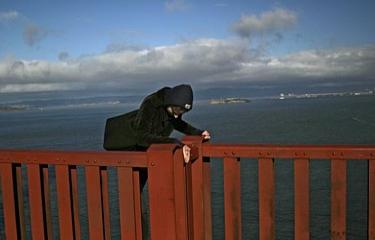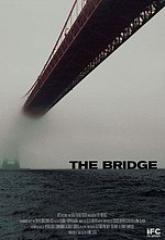
"Knight Thoughts" -- exclusive web content
Eric Steel's documentary of suicide leapers from the Golden Gate bridge is beautiful, disturbing and rightly controversial
The Snuff Film Goes Legit:
The Bridge
10-27-06 "Knight Thoughts" web exclusive
By Richard Knight, Jr.
The Bridge
10-27-06 "Knight Thoughts" web exclusive
By Richard Knight, Jr.
I’ve been troubled since seeing The Bridge last month when it was part of the Chicago International Film Fest. Now this
controversial documentary is getting a theatrical release in Chicago. The movie, which is gorgeous yet unsettling, tracks a year’s
worth of suicide jumpers off the Golden Gate Bridge. It mixes incredibly beautiful scenic footage of the national landmark, mournful
interviews with victim’s survivors ( including the friends of a middle-aged gay male ) and, most disturbingly – and here’s where the
controversy comes in – actual footage of many of the suicide victims caught on camera as they are leaping to their deaths.
As the film begins we see the enormous, spectacular rust colored bridge, gateway to San Francisco, appear out of the early morning
fog. Slowly, a normal, sunny northern California day takes shape. Cars clog the bridge during the morning commute, boaters, and
other sports enthusiasts are seen on the bay. And there’s also plenty of foot traffic and lots of tourists who we see stopping to enjoy
the view. Then out of nowhere one of these passersby suddenly, without warning, steps over the railing and leaps to his death.
The moment happens quickly and isn’t commented upon. Here, apparently, is just another day in the life of this famous landmark.
Then we begin to see on camera interviews with surviving family and friends of these suicide victims (and most vividly, one who
miraculously survived). Eric Steel, the filmmaker, who makes his debut with The Bridge, spent a year filming them from a distance.
He has said in repeated interviews that at the first moment he or one of his crew saw a person step over the railing they picked up a
cell phone and dialed 911. We actually see a few prospective leapers rescued (one woman, seen in the photo above, seems to be
in a haze and doesn’t put up any fight when hauled back over the side to safety). But on many occasions the calls from Steel and
crew were for naught and 23 people leapt to their deaths and many were caught on film. Several of these are shown during the
movie.
This snuff footage (make no mistake – that’s what it is) forces the audience, already voyeurs simply because they are engaged in
the process of watching a movie to begin with, into a realm where many may not wish to go. Others will run not walk to see the
footage. Steel has said this wasn’t his intention – that, instead he wanted to focus attention on the problem of suicide and provide a
greater understanding of the act itself. Baloney. Steel’s movie offers nothing but conjecture from survivors on this score. Nor do
the myriad of haunted, grieving relatives and friends on one hand and rationalizing realists on the other really offer much insight
into the reason why Golden Gate was the bridge of choice for their late loved ones either. No historical or psychological context is
offered (how could it? The reasons for suicide are as vast as the chasm beneath the bridge itself). After awhile though, access does
become an obvious, unstated reason why the bridge is so popular and though other monumental bridges and tall buildings have
guard barriers to prevent the act (or to at least make it more difficult), Steel’s film contains nothing on the subject or offer any
reasons why Golden Gate hasn’t erected a barrier itself.
The real reason why Steel made the movie had to be because he thought to himself, “What if I could get one of those leapers on
film?” It is a great, twisted idea albeit a rather crude one without any real compassion. How could anyone repeatedly watch such an
act over and over again and justify it in the name of art? How many of Steel’s crew walked away after seeing just one saying, “That’s
it! No more.” This isn’t exactly a case of journalism, i.e. Kennedy’s assassination in which Steel is a “witness to history” and where a
film record might serve as evidence or illumination. What Steel films are sad, fucked up people at the end of their tether who have
no idea that someone is privy to their own final solution. No permission was granted (and Steel and his crew lied to get their permits
in the first place) and certainly the victims’ privacy have been violated.
But here’s the thing – it is also a uncannily beautiful looking movie, a quietly powerful one, and perhaps the images do honor these
victims in a strange way. They are certainly unforgettable. In a weird and unexpected way, this is a snuff movie that tries to have it
both ways by honoring the deaths of those it presents (the movie's elegiac score by Alex Heffes helps). But in the end, however,
Steel’s apparent desire (unconscious or not) to push the envelope won out in the war of respect vs. sensationalism so instead of
finishing the film with the troubled but hopeful testimony from the upbeat young man who miraculously survived his failed attempt,
Steel gives in to the voyeur in himself (and perhaps the audience groomed on reality shows expert in managing viewer responses) –
and opts for something that admittedly has the same enticing quality as a car wreck. And honestly, it’s a quality that very few can
resist (I've have more people ask me about what's shown and not shown in this movie than any I can recall).
Which brings us to Gene. Steel’s great camera subject, the suicidal goth who has no idea he is starring in his own death.
Throughout we have seen him, dressed in his black clothes and dark glasses, his long black hair flying in the wind as he slowly walks
back and forth near the precipice of the bridge. We have spent the entire film ruminating on this mysterious young man – listening
to the oddly uncompassionate/compassionate stories about him by a surviving friend. One wants to look away at the same time
that one wants to see but by the time Gene goes over the side there’s an additional question and it's really unsettling: what’s going
to set his leap apart from the others? Because from the moment we've first seen him we know he’s going to jump and we know that
Steel is going to show it to us and after seeing all the other victims and hearing the interviews with their survivors (including those of
the close friend of an anguished middle aged gay male who we don’t see leap), we know that this is going to be “the one.”
Something about Gene’s death is going to set it apart from the others. Forget the guy on the cell phone who hangs up and then
walks over the edge like he's out for a morning stroll, the young lady who wobbles uncertainly as she goes over or the others. This
is going to be the money shot.
Here’s what I learned after watching Gene the goth's death and the rest of The Bridge, my first snuff film: people seem hesitant to
get involved with someone who is apparently in distress -- even when they're clearly about to harm themselves, it takes only four
seconds for a person to reach the water after leaping to their death from the Golden Gate, bodies float on impact, and worst of all
the old cliché is true – once seen, there are things that can never be forgotten.
controversial documentary is getting a theatrical release in Chicago. The movie, which is gorgeous yet unsettling, tracks a year’s
worth of suicide jumpers off the Golden Gate Bridge. It mixes incredibly beautiful scenic footage of the national landmark, mournful
interviews with victim’s survivors ( including the friends of a middle-aged gay male ) and, most disturbingly – and here’s where the
controversy comes in – actual footage of many of the suicide victims caught on camera as they are leaping to their deaths.
As the film begins we see the enormous, spectacular rust colored bridge, gateway to San Francisco, appear out of the early morning
fog. Slowly, a normal, sunny northern California day takes shape. Cars clog the bridge during the morning commute, boaters, and
other sports enthusiasts are seen on the bay. And there’s also plenty of foot traffic and lots of tourists who we see stopping to enjoy
the view. Then out of nowhere one of these passersby suddenly, without warning, steps over the railing and leaps to his death.
The moment happens quickly and isn’t commented upon. Here, apparently, is just another day in the life of this famous landmark.
Then we begin to see on camera interviews with surviving family and friends of these suicide victims (and most vividly, one who
miraculously survived). Eric Steel, the filmmaker, who makes his debut with The Bridge, spent a year filming them from a distance.
He has said in repeated interviews that at the first moment he or one of his crew saw a person step over the railing they picked up a
cell phone and dialed 911. We actually see a few prospective leapers rescued (one woman, seen in the photo above, seems to be
in a haze and doesn’t put up any fight when hauled back over the side to safety). But on many occasions the calls from Steel and
crew were for naught and 23 people leapt to their deaths and many were caught on film. Several of these are shown during the
movie.
This snuff footage (make no mistake – that’s what it is) forces the audience, already voyeurs simply because they are engaged in
the process of watching a movie to begin with, into a realm where many may not wish to go. Others will run not walk to see the
footage. Steel has said this wasn’t his intention – that, instead he wanted to focus attention on the problem of suicide and provide a
greater understanding of the act itself. Baloney. Steel’s movie offers nothing but conjecture from survivors on this score. Nor do
the myriad of haunted, grieving relatives and friends on one hand and rationalizing realists on the other really offer much insight
into the reason why Golden Gate was the bridge of choice for their late loved ones either. No historical or psychological context is
offered (how could it? The reasons for suicide are as vast as the chasm beneath the bridge itself). After awhile though, access does
become an obvious, unstated reason why the bridge is so popular and though other monumental bridges and tall buildings have
guard barriers to prevent the act (or to at least make it more difficult), Steel’s film contains nothing on the subject or offer any
reasons why Golden Gate hasn’t erected a barrier itself.
The real reason why Steel made the movie had to be because he thought to himself, “What if I could get one of those leapers on
film?” It is a great, twisted idea albeit a rather crude one without any real compassion. How could anyone repeatedly watch such an
act over and over again and justify it in the name of art? How many of Steel’s crew walked away after seeing just one saying, “That’s
it! No more.” This isn’t exactly a case of journalism, i.e. Kennedy’s assassination in which Steel is a “witness to history” and where a
film record might serve as evidence or illumination. What Steel films are sad, fucked up people at the end of their tether who have
no idea that someone is privy to their own final solution. No permission was granted (and Steel and his crew lied to get their permits
in the first place) and certainly the victims’ privacy have been violated.
But here’s the thing – it is also a uncannily beautiful looking movie, a quietly powerful one, and perhaps the images do honor these
victims in a strange way. They are certainly unforgettable. In a weird and unexpected way, this is a snuff movie that tries to have it
both ways by honoring the deaths of those it presents (the movie's elegiac score by Alex Heffes helps). But in the end, however,
Steel’s apparent desire (unconscious or not) to push the envelope won out in the war of respect vs. sensationalism so instead of
finishing the film with the troubled but hopeful testimony from the upbeat young man who miraculously survived his failed attempt,
Steel gives in to the voyeur in himself (and perhaps the audience groomed on reality shows expert in managing viewer responses) –
and opts for something that admittedly has the same enticing quality as a car wreck. And honestly, it’s a quality that very few can
resist (I've have more people ask me about what's shown and not shown in this movie than any I can recall).
Which brings us to Gene. Steel’s great camera subject, the suicidal goth who has no idea he is starring in his own death.
Throughout we have seen him, dressed in his black clothes and dark glasses, his long black hair flying in the wind as he slowly walks
back and forth near the precipice of the bridge. We have spent the entire film ruminating on this mysterious young man – listening
to the oddly uncompassionate/compassionate stories about him by a surviving friend. One wants to look away at the same time
that one wants to see but by the time Gene goes over the side there’s an additional question and it's really unsettling: what’s going
to set his leap apart from the others? Because from the moment we've first seen him we know he’s going to jump and we know that
Steel is going to show it to us and after seeing all the other victims and hearing the interviews with their survivors (including those of
the close friend of an anguished middle aged gay male who we don’t see leap), we know that this is going to be “the one.”
Something about Gene’s death is going to set it apart from the others. Forget the guy on the cell phone who hangs up and then
walks over the edge like he's out for a morning stroll, the young lady who wobbles uncertainly as she goes over or the others. This
is going to be the money shot.
Here’s what I learned after watching Gene the goth's death and the rest of The Bridge, my first snuff film: people seem hesitant to
get involved with someone who is apparently in distress -- even when they're clearly about to harm themselves, it takes only four
seconds for a person to reach the water after leaping to their death from the Golden Gate, bodies float on impact, and worst of all
the old cliché is true – once seen, there are things that can never be forgotten.



